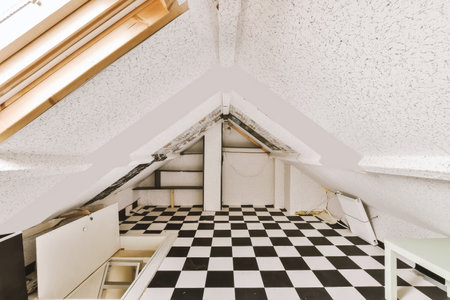Understanding the British Loft Aesthetic
Lofts in the UK possess a unique charm, intricately woven into the nation’s architectural and cultural fabric. From the raw, industrial conversions of Victorian mills in Manchester to the intimate, sloping-ceilinged attic retreats tucked away in London’s period terraces, British lofts stand as striking expressions of both heritage and adaptation. Unlike their American counterparts, which often celebrate vast open plans, British lofts tend to reflect a more nuanced approach—balancing characterful features such as exposed brickwork, original timber beams, and distinctive gables with practical considerations imposed by centuries-old architecture. The conversion of these spaces is not merely an exercise in maximising square footage but a celebration of history, local craftsmanship, and ingenuity in overcoming spatial limitations. Whether you’re navigating the quirks of a converted warehouse or transforming an underused attic above a Victorian semi, every decision is shaped by the desire to retain period authenticity while introducing contemporary comfort. This delicate interplay between past and present defines the British loft aesthetic and sets the stage for the design challenges that follow.
2. Sloping Ceilings: Creative Approaches to Space Utilisation
One of the most characteristic—yet challenging—aspects of loft living in the UK is contending with sloping ceilings. These architectural quirks, often found in period conversions and Victorian terraces, can limit usable floor space and make standard furnishings unsuitable. However, British interior design has responded with a variety of ingenious solutions that not only maximise available headroom but also introduce a sense of bespoke charm.
Bespoke Joinery: Tailor-Made for Challenging Spaces
Custom joinery is a much-favoured approach in British homes, allowing homeowners to transform awkward alcoves and low eaves into purposeful zones. Skilled carpenters craft built-in wardrobes, shelving, and cupboards that follow the pitch of the roof, ensuring every inch is put to use without encroaching on precious floor area. This tailor-made method not only boosts storage but also helps maintain an uncluttered aesthetic—crucial for making lofts feel spacious and inviting.
Integrated Storage Ideas Popular in Britain
| Storage Solution | Description | British Appeal |
|---|---|---|
| Eaves Cupboards | Low-level cabinetry fitted beneath sloped ceilings; ideal for shoes or seasonal items. | Keeps clutter at bay and preserves open floor area. |
| Drawer Units Under Eaves | Pulled out horizontally from under the slope; perfect for clothing or linen. | Makes use of awkwardly shaped voids while remaining discreet. |
| Open Shelving | Shelves following the angle of the ceiling; displays books or decorative objects. | Adds character and visual interest common in eclectic British interiors. |
| Daybeds & Window Seats | Built-in seating tucked beneath dormer windows or slopes. | Creates cosy nooks beloved in traditional British homes. |
Clever Layout Strategies
Beyond fitted furniture, thoughtful layout choices are key. Positioning beds or desks where headroom is lowest—while keeping main circulation areas clear—ensures comfort without wasted space. Using light colours and reflective finishes further opens up rooms visually, counteracting any sense of confinement imposed by the ceiling’s angle. These practical yet stylish solutions embody the British knack for marrying function with homely appeal, turning loft challenges into opportunities for individualised design.

3. Navigating Awkward Layouts: Zoning and Flow
Loft conversions in Britain often present idiosyncratic footprints—a legacy of Victorian, Edwardian, or post-war architecture—which can feel more like a puzzle than a blank canvas. The key to transforming these irregular layouts into functional and harmonious living spaces lies in strategic zoning and careful circulation planning. Start by identifying the natural zones suggested by the structure itself: alcoves beneath sloping eaves can be cleverly repurposed as reading nooks, storage, or even compact home offices, taking inspiration from the British tradition of making the most of every inch.
To ensure a logical flow through the space, think about how daily life will unfold. Place high-traffic areas, such as entrances or stairways, so they lead smoothly into communal zones like sitting rooms or kitchens. Use partial walls, open shelving, or even subtle changes in flooring materials to delineate different areas without sacrificing the open feel that is prized in loft living.
British ingenuity shines in making awkward corners not only usable but delightful. A window seat carved out beneath a dormer, or a bespoke wardrobe fitted into an angled recess, demonstrates a resourceful approach that balances practicality with charm. By layering zoning techniques with a keen eye for detail—hallmarks of thoughtful British design—you can turn convoluted floorplans into inviting homes that celebrate character rather than compromise it.
4. Light and Atmosphere: Harnessing Natural and Artificial Illumination
Creating a welcoming and functional atmosphere in loft conversions hinges significantly on mastering both natural and artificial lighting. Sloping ceilings, particularly those under the eaves, often pose unique challenges, limiting how daylight enters and how fixtures can be positioned. However, with careful planning and a nod to British preferences for layered, subtle illumination, it is possible to transform even the gloomiest corners into bright, inviting spaces.
Daylight Strategies for Under-Eaved Spaces
Maximising daylight is paramount when dealing with awkward layouts and low ceilings. Incorporating architectural elements such as skylights, dormer windows, and light tunnels not only increases brightness but also enhances spatial perception within the loft. Skylights fitted between rafters allow for direct overhead sunlight, making even the most compressed areas feel airy. Dormers add both headroom and the opportunity for vertical glazing, which can provide a more traditional British window aesthetic. Light tunnels—sometimes called sun pipes—are especially useful in tight or internal spaces where conventional windows are impossible.
Comparing Daylight Solutions
| Solution | Best For | Key Benefits |
|---|---|---|
| Skylights | Open roof sections with limited wall space | Direct light, modern look, good ventilation options |
| Dormers | Adding usable space under sloped roofs | Traditional style, increased headroom, outward views |
| Light Tunnels | Internal or deep-plan areas without direct roof access | Natural light in previously dark spots, discreet installation |
The British Approach to Artificial Lighting
The typical British home values a blend of ambient (background) and task lighting to create warmth and versatility throughout changing seasons. In lofts with challenging angles, recessed spotlights work well in flat ceiling sections, while adjustable wall lights or floor lamps can provide focused illumination where needed. Pendant lights hung from the ridge beam or at varying heights help define zones within open-plan lofts.
Layered Lighting Techniques Popular in the UK:
- Pendant Lights: Often used above stairwells or reading nooks for visual interest.
- Wall Sconces: Ideal for sloping walls where table or floor lamps aren’t practical.
- LED Strip Lights: Fitted along beams or under shelving to highlight architectural features.
- Table and Floor Lamps: Provide flexible solutions for changing needs and seasonal moods.
The combination of clever daylight strategies with considered artificial lighting ensures that converted lofts retain their charm while meeting practical demands—a balance deeply appreciated in British homes where atmosphere is as important as function.
5. Materiality and Texture: Contextual Design Choices
One of the defining characteristics of British loft conversions is a sensitive interplay between heritage materials and contemporary interventions. Rather than erasing the quirks of sloping ceilings or awkward eaves, designers often choose to highlight these architectural features through materiality—a distinctly British approach that honours the past while embracing the present.
Heritage Materials as Storytellers
Exposed brickwork, a staple in many Victorian and Edwardian-era buildings, is frequently revealed in loft spaces to provide texture and a sense of place. The patina of original bricks contrasts beautifully with crisp, modern finishes, creating a layered aesthetic that feels both grounded and dynamic. Reclaimed timber beams—often left bare or lightly treated—introduce warmth and authenticity, celebrating the buildings history while addressing structural challenges posed by unusual rooflines.
Blending Old and New
This blending of eras is further accentuated by period fixtures such as cast iron radiators, vintage light fittings, or traditional sash windows. These elements serve not only as visual anchors but also as tactile reminders of the buildings narrative. In true British fashion, even the smallest details are considered: brass door handles with gentle wear, hand-thrown ceramic tiles, and woollen textiles all contribute to a space that feels curated rather than contrived.
Contextual Choices for Modern Living
Making material choices in a loft conversion is rarely just about aesthetics. The practicalities of insulation, soundproofing, and maintenance must be balanced with a desire to retain character. For instance, lime plaster might be used on uneven walls for breathability and texture, while engineered oak flooring offers durability without compromising on historic charm. By embracing both the idiosyncrasies of the architecture and the rich palette of British materials, designers create lofts that feel uniquely at home in their context—spaces where every slope and surface tells a story.
6. Overcoming Regulations and Planning Challenges
When transforming a loft with sloping ceilings and unconventional layouts, navigating the maze of UK building regulations and planning requirements is as critical as the design itself. Loft conversions are subject to strict rules that vary between England, Scotland, Wales, and Northern Ireland, but certain considerations are universally significant across the UK.
Understanding Permitted Development Rights
Most loft conversions fall under “permitted development” in many British homes, meaning they don’t require full planning permission. However, there are caveats: your conversion must not exceed a specified volume (40 cubic metres for terraced houses, 50 for detached and semi-detached), must not overhang the original house’s roof slope facing the highway, and should use materials similar in appearance to the existing house. For properties in conservation areas or listed buildings, stricter controls apply.
Building Regulations: Safety First
Regardless of whether planning permission is needed, all loft conversions must comply with UK Building Regulations. Key areas include:
Fire Safety
This is paramount; you’ll need appropriate fire doors, escape routes, and possibly mains-powered smoke alarms on every floor. For homes with three or more storeys post-conversion, a protected staircase may be required.
Structural Integrity
The new floor structure must safely support additional loads. This often involves steel beams or strengthening existing joists—solutions that need careful integration into quirky layouts and sloped ceilings.
Thermal Efficiency & Insulation
Sloping roofs pose challenges for insulation depth without sacrificing headroom. Use high-performance insulation boards to maximise space while meeting U-value targets.
Innovative Design within Regulatory Boundaries
Complying with regulations doesn’t mean stifling creativity. Consider bespoke built-in furniture to navigate awkward corners or dormer windows to boost both usable space and natural light—provided they fit within permitted development limits. Skylights can also be installed on the rear roof slope without planning consent in most cases.
Professional Guidance: Your Secret Weapon
Navigating these rules demands expertise. Employing an architect or specialist loft conversion company familiar with local authority requirements is invaluable—they’ll ensure your innovative solutions remain firmly above board and help you avoid costly mistakes or enforcement action down the line.
Tackling regulatory hurdles with foresight allows you to transform even the most challenging loft spaces into comfortable, compliant, and characterful parts of your home—a true testament to British ingenuity in interior architecture.

